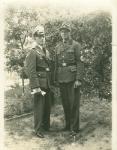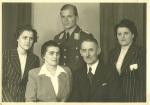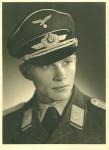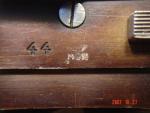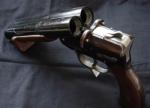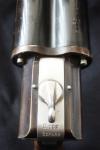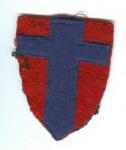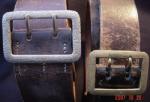
John Burchell
Valued Member-
Posts
285 -
Joined
-
Last visited
Content Type
Profiles
Forums
Blogs
Gallery
Events
Store
Everything posted by John Burchell
-
Belgium Medal ID assistance, please?
John Burchell replied to John Burchell's topic in Northern European & Baltic States
-
Belgium Medal ID assistance, please?
John Burchell posted a topic in Northern European & Baltic States
Here's a cased medal which I picked-up in a shop in Arras, France last month while visiting the nearby Vimy Memorial. I have searched in vain to determine what it represents. Could someone please assist with an identification? Thanks and regards, John -
Hello Joe: Thanks for your posting regarding the KM acceptance mark (the eagle/swastika MIII/3 proofmark on the receiver = Abnahmestempel der Abteilung lll des Marinezeugamtes 3). I have examined this again carefully in light of your comments. The picture does indeed make the stamp look like it was done more recently, but in-hand, this does not appear to be the case. I stand to be corrected but will explain why, based upon my own research into the matter. This later model Walther flare gun is the anodized aluminum version. The anodized finish was applied after the serial number and other maker marks were placed on the gun by the manufacturer, which is why they appear to be age toned. Important to note is that the KM acceptance mark is not stamped on the wood, as you indicated. The navy acceptance mark was die-stamped onto the metal portion of the receiver after the anodizing process was completed, so does not have the anodized patina or finish like the rest of the metal parts of the reciever. This process of inspection and proof-stamping of equipment was done by the appropriate navy officials/inspectors - either at the Mauser factory before being shipped to the KM arsenals; or at large naval installations, such as Kiel, before being distributed throughout the Kriegsmarine. Thanks again for pointing-out this feature, which has added value to the thread. Best regards, John
-
Well, one lives and learns...and that is a good thing. However, sometimes the truth hurts. Read on.... A fellow collector has pointed-out that there appears to have been a modification made to my gun pictured here, specifically, the breech end of the barrels having been re-chambered. Note the "shiny" area visible in the picture. This extends into each of the barrels for about 1 cm., which I am told should not be the case. I certainly believe this one to be a factory original, and when this was pointed-out to me, wondered if it might be a period or post-war modification, and for what reason - the only one I could imagine possibly being to accommodate a different type of flare cartridge. What I am told is that if the 1 cm. "shiny" area is of a slightly larger diameter than the bore (which it is), it has definitely been altered and that this would not have been done wartime by the Germans, and that most probably it was done by someone post-war to accomodate a 4-gauge tear gas or shotgun shell with a thickened area around the base of the shell....or...someone also might have made an insert, and then had to relieve the chamber to get it to fit. All of which probably renders it unsafe to fire, the flaregun walls having been thinned, making it dangerous for a shotshell, and even with 4-gauge flares, which would no longer fit snugly into the chamber and the gap could cause a shell rupture. Sadly, this decreases the value of this flaregun, although it does remain a lovely, period piece of KM history. As I do not wish to be seen as presenting an item that is inaccurately described, or deceptively described by omission, I have added this new information so that all can learn from it. Regards, John
-
Unfortunately, not definitively, Scott. That photo is not dated as such. However, I have another photo (see below) of the man next to the RAD chap which is dated 1938 in pencil on the reverse, and I thought that both photos may have been taken at or around the same time, although one cannot be certain. Upon close study of the photos, this fellow seems to be wearing the same uniform, hat, shoes and is also wearing the white gloves that he is holding in the other "RAD" photo. However, the cross-strap is not evident, so it may well have been taken in 1938 and the "RAD" one at a quite different time, in fact, a few years earlier. In examining the photos again under magnification, I believe that the buckle on his belt (in the photo with the RAD man) is not a LW buckle, rather, it appears to be one of the Reichs Luftsport Verein (RLSV) of the type issued from 1933-35. However, he clearly has the early, droop-tail LW breast eagle on his uniform which I believe came into use when the LW became official in 1935. Although not a subject in this particular forum, I am curious as to the reason for your question. John
-
Well, it has taken a while, but here goes! Here are some photos of a young German who - if my research on this forum is correct and judging from his collar tab Waffenfarbe and insignia (although difficult to be certain of the colour from black & white photos!) - may have belonged to an Engineer Corps or an Air Ministry Construction Unit. I am sure that some verification can be obtained here. The first picture shows one gull with no bullion tape (rank of Flieger) on what I think to be a black Waffenfarbe background. Given the nice droop-tail eagle breast insignia, this picture would have most likely been taken during or pre-1939. The next picture shows him with one gull and tape (rank of "Unteroffizier") with the same "Waffenfarbe" background. Then the third picture (dated 1941) showing three gulls and tape (rank of Feldwebel), same Waffenfarbe. Photo number four (dated 1942) shows him with a bullion half-wreath and one gull (rank of Fl. Ingenieur Leutnant) on what I believe to be a pink Waffenfarbe background material. What do you folks think? Hope this makes for an interesting contribution and that this posting is in the right place. Regards, John Comment from "luftguy": Thanks for posting this interesting set of photos. The tabs in the last photo do appear to look like other pink tabs as represented in black and white photos. Comment from "Paul R": Thank you for posting these great photos!! While the are not members of the Corps of Engineers(These are Construction Troops), they are very interesting! NB: Two other photos of this same fellow appear in my related posting here: http://gmic.co.uk/index.php?showtopic=16815 Photo 1.
-
Czechoslovak Stickpin
John Burchell replied to John Burchell's topic in Central & Eastern European States
Thanks, Nick. Much appreciated. Mine came from a vet who was in the Royal Canadian Air Force and spent time in Britain as well as on the continent during the war, which was when/where he acquired it. John -
Rick kindly identified this stickpin for me and noted (here: http://gmic.co.uk/index.php?showtopic=22639 ) that it was used 1920s - 1940s. I will cut and paste the description here for ease of reference by Forum Members: [this stickpin at one time had a gold finish, traces of which are still visible in the recessed areas. Being the highpoint, the area at the top of the wreath and just below/between the wings is worn but, under magnification, depicts a lion rampant. I believe that the vertical portion through the centre of the wings and wreath is a sword - the hilt or crossguard of which can be seen, while the grip appears to have been broken-off. The pin measures approximately 2cm. from the top of the wings to the bottom of the wreath. The wingspan measures 2.5cm. The 2.5cm. retaining pin on the reverse has been repaired or replaced, judging by the blob of solder present. The piece is non-magnetic.] Any indication of desirability and approximate value - in this condition - will be appreciated. Thanks, John
-
Here is a beauty which I would like to share with Forum members. This is a Walther Model SLD (Signal und Leucht Doppel) double-barrel flare gun, in this case the anodized aluminum version (versus the earlier stainless steel one). Note the maker code "eeu" in a rectangle and the eagle/swastika MIII/3 proofmark on the receiver, as well as the eagle and "4" within a circle on the top of each barrel (indicating the type/gauge of flare to be used). I understand that some 6000 of these were produced in 1943 and 44, this one being #5021 from 1944. Although they were produced for the U-Boats, they were also used aboard other ships. Comments are most welcome. Thanks, John
-
Would appreciate some comments on the following items, please, confirming more precisely what they represent and relative desirability by collectors. 1. A shield-shaped patch that I believe was worn by both British and Canadian "Line of Communication" units during WW2. Not particularly scarce, I suspect. 2. Three general issue cap badges of a WW1 Machine Gun Batallion (per Babin #31-1) as would have been worn by most Empire MG troops in WWI, and certainly Canadian or British. Not sure what is the significance of the silvered one...for officers, or maybe for post-WW1 wear? 3. A 1919-dated, serially-numbered Swiss-made stop-watch for military use, perhaps - given the British "broad arrow" marking. Dont know what the "O.G. Fulda" means - related to Fulda in Germany, or perhaps the maker's name? Thanks and regards, John
-
Here are a couple of leather belts that came with this lot. The leather belt on the left is 5.5cm. wide, has a larger buckle with a faint golden tone to it (but is really more silver than gold) and is maker-marked with "RZM 110". The leather belt on the right measures 4cm. wide, has a clearly gold finish and the belt is stamped "CROUPON / C.O.G. Nr.56". I am not sure if these were belts used by the KM-KA (eg. brown vs. black) and would like to know for sure, if possible. Any idea?





